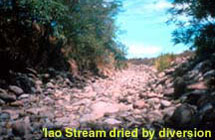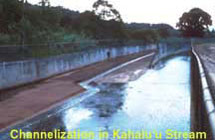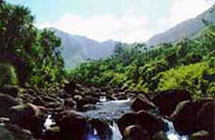Protection
What Can You Do to Protect Streams and Native Animals?
There is no question that Hawai‘i’s streams were once prime habitats for an abundance of native freshwater species. Tales of streams with clear running water filled with ‘o‘opu and ‘ōpae are now mostly referred to in the past tense. Whatever happened to our streams and the animals that once inhabited them in such great numbers? The answer is simply that there are so many more people living in Hawai‘i today than ever before. Back in the early 1900’s, the population in Hawai‘i numbered about 150,000 people. Today, the population is over 1.3 million. Within this relatively short period, many streams in Hawai‘i have been diverted for agricultural irrigation and ranching. Increasing populations also resulted in more development and urbanization with all the attendant impacts. As a result, many of our streams today, especially on O‘ahu, are altered by channelization, diversion, damming, and dumping, resulting in restricted flows, elevated temperatures and an abundance of introduced alien species.
Despite these continuing problems, there is still reason for optimism. There are still many streams, primarily on the neighbor islands (islands other than O‘ahu), that contain reasonably healthy populations of native stream animals and every effort is being made to protect them as best we can. Even altered streams still provide some habitat for native freshwater species. In this light, we can still take positive steps toward restoring and improving these habitats for Hawai‘i’s native freshwater species.
To begin with, let’s review the basic foundation needed for a stream to provide good habitat for native aquatic animals:


- Maintaining the mauka-makai lifeline (connection to the sea) to ensure healthy populations of native stream flora and fauna. Since native stream animals need to migrate to and from the ocean to complete their life cycles, an almost continuous flow into the ocean is the utmost priority. Above, a photo of ‘Iao Stream (Maui) dried by diversion of water.
- Riparian (streamside) vegetation is needed to help prevent erosion of the banks and reduce unwanted sediment and nutrient load into the stream ecosystem. Native stream animals thrive best when the water is as clear and clean as possible. Riparian vegetation also creates a canopy over the stream which provides shaded areas and the cooler water which native stream animals prefer. Stream channelization removes the riparian vegetation which provide shade for the stream. The combination of direct sunlight and absorption of heat by the concrete channel increases water temperatures which favor the proliferation of alien species and is adverse to native species. In addition, the rocks and boulders needed to provide shelter and protection for native stream animals are removed.
- Preventing the release of any additional alien species into any stream system is also very important. Alien species compete with native stream animals for food and habitat, prey on native species, and harbor parasites and diseases that can harm native species.
Keeping the above-mentioned in mind, what can we ALL do to help improve and protect Hawai‘i’s stream ecosystems? We cannot do everything needed to restore all the streams to the pristine conditions they once had been. However, the following activities would improve the habitat and enable native stream animals to thrive:


- KEEP THE STREAMS CLEAN. Create and/or participate in stream clean-up programs such as the City & County of Honolulu’s Adopt-A-Stream Program. Dispose of litter properly. Even if litter is not thrown directly into the stream, the wind can easily blow it into the stream or it can flow into a stream with some heavy rains or through the storm drain.
- DO NOT RELEASE ALIEN SPECIES into the streams or any other natural aquatic environment – it is against the law. Please return unwanted aquatic animals to a pet store or to a Humane Society or other animal shelter. As mentioned before, alien animals compete with native species for food and habitat, prey on them, and introduce parasites and diseases that can harm native species.
- MINIMIZE POLLUTION by reducing activities such as car washing and watering the yard after using chemicals and fertilizers in the area. Minimizing these activities not only helps to conserve water, but also minimizes soap and other chemicals that may end up in streams through storm drains. Storm drains concentrate runoff of sediment, nutrients, and other sources of pollution into streams causing the habitat for native animals to deteriorate. To better illustrate this, think of your driveway and street as a dry stream bed that is a “tributary” of your neighborhood stream. When it rains, everything on it will flow down the storm drain and into the stream. Keep your driveway free of spilled oil and fix leaky radiators as soon as possible. Use only prescribed amounts and types of fertilizers and pesticides and apply only when the weather is dry.
- LEARN MORE about stream ecosystems through environmental education activities offered by organizations such as the Hawai‘i Nature Center, Moanalua Gardens Foundation, the Honolulu Board of Water Supply, and through educational activities at your local school.
- ATTEND AND PARTICIPATE in neighborhood board activities, especially if it involves streams that are an important part of your neighborhood.

All these activities not only help to conserve Hawai‘i’s stream ecosystems, but they also promote a sense of respect, stewardship, and responsibility that we must have toward these islands which are our home. As long as we try our best to take care of our environment, it will always take care of us.
Photos: Division of Aquatic Resources
